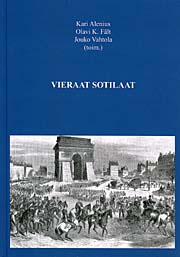|
Studia
Historica Septentrionalia 45
|
|
|
Kari
Alenius, Olavi K. Fält, Jouko Vahtola (Toim.),
Vieraat sotilaat.
Seminaari Oulun
yliopistossa 5.2.–6.2.2004.
Pohjois-Suomen Historiallinen Yhdistys, Rovaniemi 2004. 276 pages
|
 |
Summary:
Sinikka Wunsch, From hordes of cossacks to bombing fliers.
Exploiting the stories of oppression during the period of Great Hate
in the image of the enemy during the Winter War.
Vieraat sotilaat. Studia Historica
Septentrionalia 45 (2004), 65–82.
Also before in history the Russians
have rampaged as assassins in this country and… have rampaged
especially here in Kainuu. During the period of Great Hate they
burned homes, raped women and butchered children by impaling them on
fence posts and leaving them to suffer… But after the years of
oppression the oppressors witnessed how the Finnish people arose
again just as tenaciously and strongly and thirsting for life.
The above text was published in Kainuun
Sanomat on February 13, 1940 during the Winter War. The quotation
illustrates the most essential allegory of the image of the enemy in
the Winter War: an example that paralleled the current struggle was
found two centuries before, from the period of Great Hate. During the
Winter War the enemy was not able to occupy Finland. However, it was
present at another level, in people’s minds, or as we would say today,
in a virtual form. My presentation concentrates on how this virtual
enemy was exploited by the wartime press and how it was used to create
a defensive, fighting spirit in the people, and where the roots of
this image were.
Two poems present an authentic image of
the enemy during the period of Great Hate. One was written by
Bartholdus Vhael, vicar of Ilmajoki: “A grievous elegy of the
sorrowful Finnish people, the inhabitants of the far North” was
originally published in Sweden in 1714 in Finnish. “Finnish poems of
sorrow” by Gabriel Calamnius, a clergyman in Kalajoki, was written in
1720 when Calamnius was a captive of the Russian occupiers.
A more extensive and recent source of
stories about oppression that were exploited during the Winter War is
found in the narratives about the years of war and oppression stored
in the archives of folklore. They were mainly collected in the early
1900s and mid-1930s. They include many stories of oppression connected
to the period of Great Hate as told by the people, which shed light on
the roots of the image of the enemy, at least during the Winter War.
The process by which they have been passed on by the people until the
1900s and finally appeared in newspaper articles during the Winter War
would be an interesting topic of research and contemplation.
That a clear model of the enemy in the
Winter War was found over two hundred before is logical, based on
general conformity to the laws of the process of creating images of
the enemy. The occupation during the period of Great Hate (1713–1721)
is an exceptionally difficult time in Finland’s history, and in a
certain sense the events can be viewed as genocide. On the other hand
it contains a comforting message: even then the Finns, who were
forsaken by all to fend for themselves, were finally able to survive
their oppressors and enemies.
In the image of the enemy in the Winter
War, especially the bombers represented the hordes of Cossacks that
terrorised civilians in the old image of the enemy. They were an
example of what would happen to the people if the enemy was able to
enter the country.
Takaisin Studia Historica
Septentrionalia 45
|